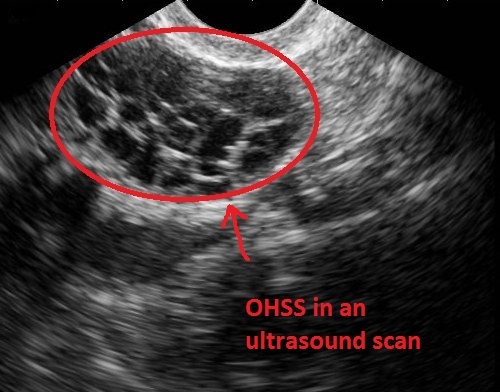Ovarian Hyper Stimulation Syndrome (OHSS) is a potentially serious complication of fertility treatments where the ovary is artificially stimulated. It occurs in about 5% of all IVF treatment cycles, and is severe in about 1% of all cycles. It generally begins to cause problems about 4 or 5 days after the egg pick up procedure (or after ovulation in non-IVF cycles).
The ovary swells up quite dramatically and leaks large amounts of protein-rich fluid inside the abdomen. This fluid comes from the blood stream which is then left very concentrated, so there is an increased chance of blood clots forming. Very rarely, OHSS can be so severe that it is fatal.
Why Does OHSS Occur?
For OHSS to develop, you need to have had some form of ovarian stimulating drug. Generally, this is FSH injections, but it has been known to occur with clomiphene. To trigger the onset of the problem you then need for ovulation (or a trigger injection) to occur. OHSS usually lasts for about 10 days, but if you become pregnant, it can last for some months and tends to be worse.
OHSS is more common in younger women, women with polycystic ovary syndrome, women with high levels of oestrogen during their cycle, or large numbers of follicles developing on the ovary. Women who have had it before are at high risk of having it happen again.
Methods To Prevent OHSS
In order to try to prevent OHSS occurring, the dose of ovarian stimulating hormones should be minimised, while still aiming for a “good” ovarian response – say 6 to 10 oocytes (eggs). This is why younger women will generally have a much lower dose of FSH than older women.
If a doctor considers a patient is at high risk of developing OHSS, they will recommend that the cycle be cancelled, and you stay on your down-regulation drug (if you are taking this), so that you won’t ovulate. Sometimes, an egg collection is performed, but all the suitable embryos/blastocysts are frozen, so there is no chance of you getting pregnant and ending up sick for weeks and weeks.
Even with these precautions, there are still a number of cases of OHSS from time to time.
OHSS Symptoms
If you are developing OHSS, your tummy (abdomen) will get bigger and quite sore. The increased fluid inside your abdomen can be quite a lot and make you look like you are several months pregnant. As your abdomen increases in size, you get increasing pain, pressure on the bowel which produces nausea, vomiting, and constipation. As the fluid builds up, it causes pressure on the kidney, which reduces your urine production. You may urinate less often and it might be dark yellow.
As the fluid increases, it can also press on your lungs and make it difficult to catch your breath. Breathing may become painful. This tends to be worse when you are lying down. You can also get marked swelling on the outside of your genitals.
If you are experiencing abdominal pain that is getting worse – rather than better – after your egg pick up, and you feel nauseous or are vomiting, let your clinic and/or fertility specialist know. If you do choose to use the local Emergency Department then INSIST that they ring your IVF specialist or the Doctor on call for your clinic before they send you home.
Treatment For OHSS
You should be seen by a fertility specialist who will examine you and arrange for some blood tests to be done. If it is a fairly mild case then you may be sent home with pain killers, an anti-nausea tablet, aspirin to prevent blood clots, and instructions to rest and have a high fluid intake. Even though you feel you are “bursting,” ensuring you are at least drinking 6-8 glasses of water a day will help to replace the fluid you are losing. The doctor will want to review your progress over the next couple of days to make sure you are getting better.
If you have a severe case, then it will be recommended that you be admitted to hospital. You will have an intravenous drip to provide you with fluids. You will be given strong pain killers and anti-nausea medications. It is important that exactly how much fluid goes in and how much comes out is monitored, which tells us how well your kidneys are coping. To do this accurately, it may be necessary to put a catheter into your bladder.
You will be asked to wear compression stockings, take aspirin and have daily injections of a blood thinner to reduce the risk of a blood clot forming. If there is a very large amount of fluid collecting in your abdomen, a drain tube may be inserted to relieve the pressure.
Regular blood tests will be done to monitor your progress and you will be kept in hospital until you are getting better, which might take several weeks.
The best cure for OHSS is prevention. That is why your specialist will consider your age, your reason for infertility as well as your blood levels of Follicle Stimulating Hormone (FSH) and Anti Mullerian Hormone (AMH). All these factors will assist your specialist in arriving at a dose of injectable FSH that is suited to you and less likely to result in OHSS occurring.
If you have further concerns about Ovarian Hyperstimulation Syndrone, please call us on (07) 5478 2482 (Sunshine Coast) or (07) 4151 5222 (Bundaberg).


